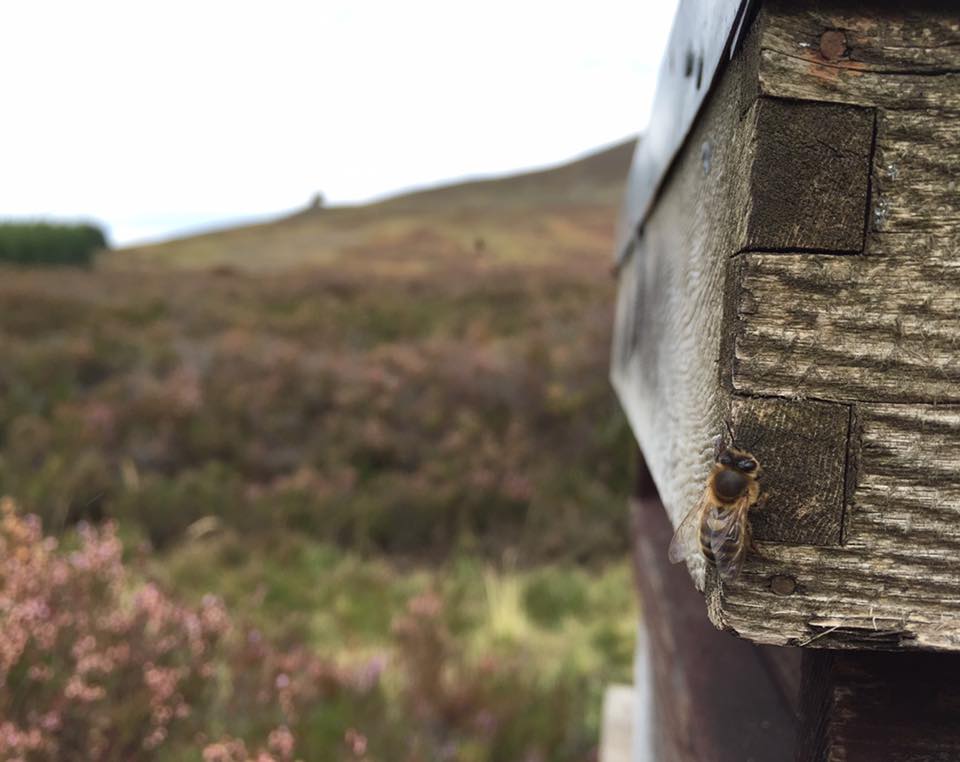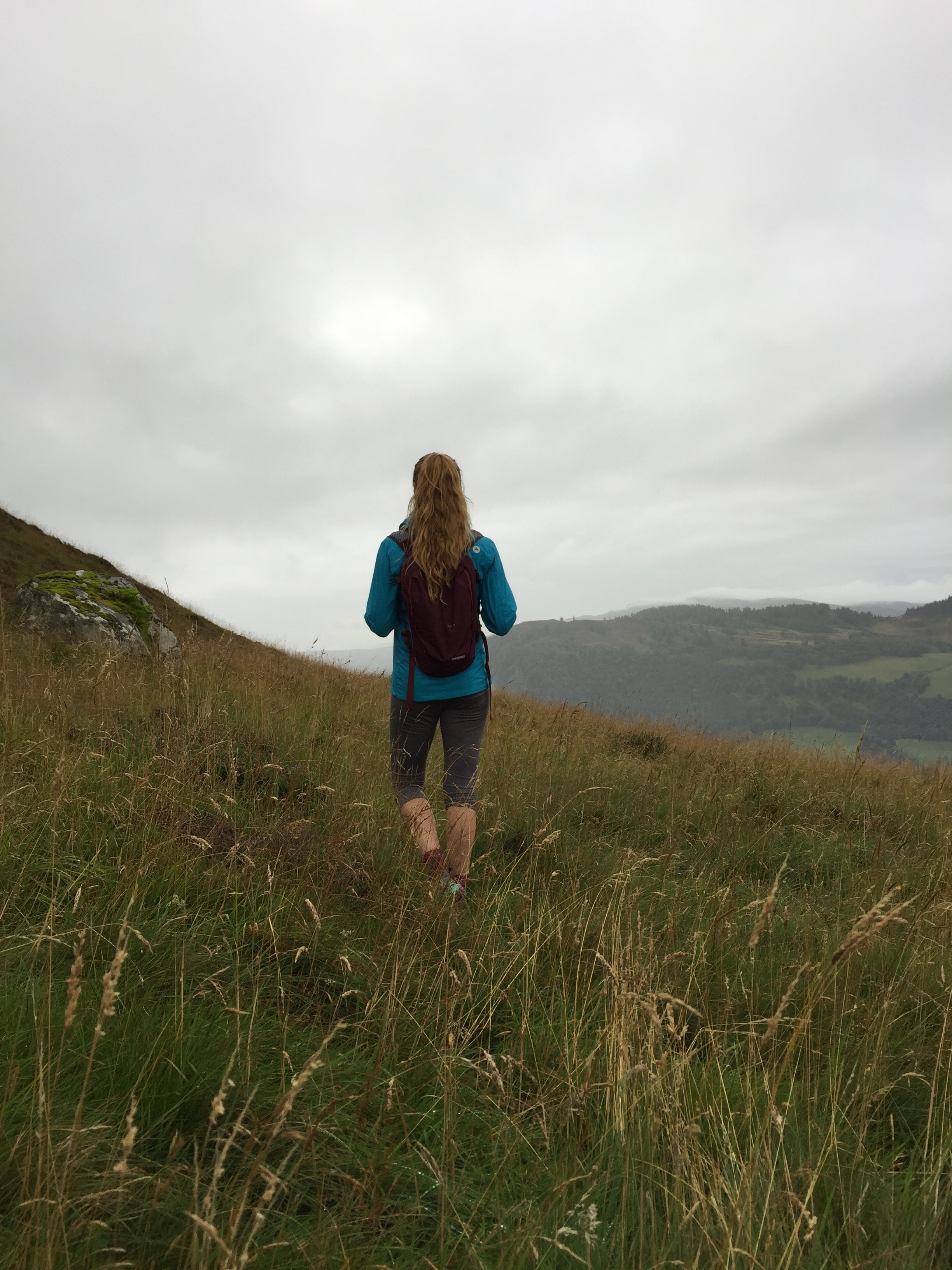Chasing Striped Fairies Through Scotland
When a bee flies over a flower, she receives an electric message. A flower that needs to be pollinated is burgeoning with nectar and pollen, and carrying a negative charge. The awaiting flower calls out to the positively charged hungry bee with a pull.
As I flew north from London in early 2014, on a rare clear day, I peered out the window at what was apparently Scotland. A strange magnetism overtook me. It was so green, mountainous, vast, and mysterious. I felt like a transfixed bee, pressed against the jet window, longing to fly out and down to the flower-clad hills calling from below.
I held on to this curious pull for two years, until my chance to buzz back over the pond came. I was invited to speak at the Scottish Beekeepers Association’s Autumn Convention, on the topic of bringing sustainability to the art of beekeeping through teaching the craft to kids. More on my ‘Kids and Bees’ program here.
Speaking on my favorite topic (bees) was my pathway to bonnie Scotland, and I began to revel in the thought of seeing every castle garden, hunting down every bee, and climbing every heather-draped hill that I possibly could.
While sitting at the kitchen table with my hosts in Inverness, you can imagine the gleeful noise I made when I found you can openly and officially, by the 2003 Land Reform Act, traipse around the hills like a free little wood nymph!
After a lovely stay with my beekeeper hosts, nightly whiskey drams, and a fantastic “tartan weekend” beekeeping conference, complete with haggis (which I loved), I loaded up my Lariat 55 and was off to stay in a remodeled hayloft in the heart of the Highlands, near Killiecrankie.
The loft was halfway up a mountain pass, nearly at the end of a rural driveway that switch-backed up a steep emerald hillside, dotted with dim-witted wide-eyed dingle-berried cotton balls. As many smaller estates have done, the farm house at the top of the hill had partitioned off the barn and hayloft, no longer in use, and turned them into guest cottages to earn a buck from adventurous travelers.
I nestled into my hayloft in the clouds with the setting sun and lucidly dreamed of the Highlands. To my delight, when my hostess dropped off the basket of breakfast fare in the morning, she let me know that I could just wander to the end of the track (driveway), and start up the Munro (extremely large hill) from there. Just mind the gate after me. No dogs, no aggressive signs, no barbed wire (as common in my home turf in the Western US) - just mind the gate so the sheep don’t escape.
As I walked gingerly by the sheep, Highland “coos,” and through the neighbor’s back yards, I felt like I was doing something wrong. “Someone is going to spring out their back door and yell at me,” I thought. As I plodded on, I saw a sign mounted on the gate ahead. “Ah, this is it, get ready to turn around,” I said to myself. I got closer, and the words on the sign came into focus, “Welcome to Old Mill, Ladeside.” A welcome sign on private land?! I smiled from head to toe. A feeling of gratitude, empowerment, and freedom washed down me. I proceeded to the gate, went through, and eyed the top of the mountain. Between where I stood, and the looming Scots Pine above, was an inviting and open playground for me to zig zag about as I pleased.
I headed out along a dry stone wall, and became instantly struck by the lichens blooming on the hand lain ancient structure. I could almost feel the stones telling stories of the centuries that they have seen. With little doubt, these rocks have watched many generations of farmers, sheep, and “coos” steward the land. As a walked, I let my mind wander through the family trees that both my mom and dad shared with me, prior to my departure. My genes weave me were here, on this land, for over seven centuries. I wanted to sit a spell and try to imagine life here before the Highland Clearances, and maybe jot down a poem in my journal. However, the heather on the hills above was calling me, and I was abuzz with excitement for what I would trip upon next.
While I never saw another human on my hours-long foray into the wilds, I never felt alone. Scotland is not only famous for its whiskey, wool and heather honey, local folklore is also a celebrated national treasure. You’ve no doubt heard of Nessie, the Loch Ness monster. A host of other creatures of myth and legend weave themselves through the culture, as well. The pre-Christian era is rich with history of fairies and other creatures, all tied to the natural landscape. The rivers are home to the Bean Nighe and Kelpies. Ghillie Dhu is a guardian spirit of the trees. And of course, the Fairies, of which there are over a dozen clans spread all over Scotland. The national animal of Scotland is the Unicorn, so it’s safe to say the Scottish aren’t shy to share their mythic roots.
I can honestly say that I felt it. The magnetism that I first felt while jetting above two years ago was real. Now I was here on this heath, not 20 miles from Schiehallion Mountain*, where the weight of the world was measured in 1774. I felt a curious combination of being elated and grounded at the same time.
With every step, I felt wrapped up in the history and the present. Woodland fairies seemed to take many shapes. I found my fairies in the form of clumsy striped bumble bees, skipping from one thistle to the next. I saw a herd of red deer, elegant and noble. Even the chic little black slug had a magic and mysterious air about her.
I climbed above the tree line, and found the hill to be surprisingly steep. I pulled myself up, hand-over-hand, with the heather. When I reached the top corner of the fence line, I wrapped myself in my plaid and lay in the moss, using my Lariat 55 “adventure pod” as a pillow.
As the tepid mountain mist soaked me to the bone, I experienced an overwhelming sense of euphoria for the opportunity to come to this place, for the spirits that kept me company, for the bees that bring so many gifts into my life, for the beekeepers who hosted me, and to the openness of the people and the land in Scotland.
While I’m happy to be back to Oregon now, I know that the rivets of my DNA are lined with the heather and stone of those steep hills and small walls. And I feel a pressure in my chest, weighting me back to Scotland.
*Gaelic translation: “The Fairy Hill of the Caledonians”
For more pictures of my adventures in the Highlands, visit this link.




